Green beans are native to Central and South America. 16th-century Spanish and Portuguese explorers introduced them to Europe, where they quickly became a staple food.
Today, they feature prominently in stir-fries, salads, casseroles, and other favorite dishes worldwide. It’s hard to imagine Thanksgiving without a green bean dish or two.
Green beans offer a wealth of nutritional benefits, including:
- Vitamins A, C, and K
- Fiber and folic acid
- Minerals like potassium and iron
- Antioxidants that protect against chronic diseases
Unless you’ve tasted a green bean fresh from the garden, you have yet to experience its full flavor potential. Vine-ripened and freshly picked beans are:
- Sweeter
- Crisper
- More succulent
- Higher in nutritional value than store-bought beans
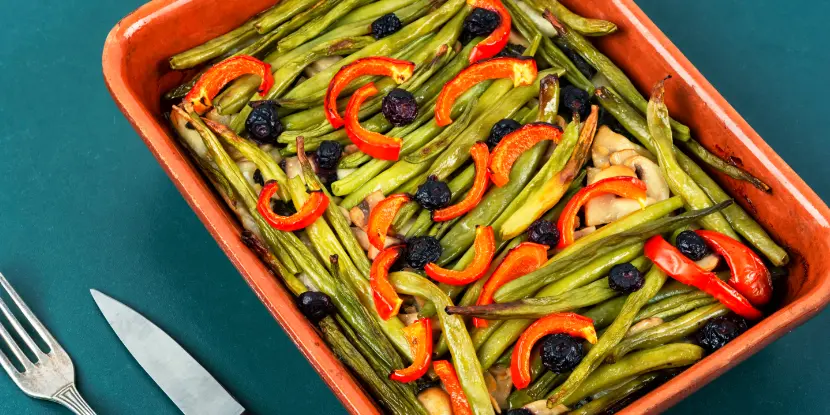
No Thanksgiving dinner is complete without a green bean salad or casserole.
Choosing the Right Variety of Green Beans for Your Backyard
Climate, soil type, and your personal preference will determine which variety is best for your Southern California garden. Here are a few popular options:
- Bush Beans: These compact plants grow about 2 feet tall and require minimal support. They produce a concentrated harvest over a short period, making them ideal for smaller gardens.
- Pole Beans: As the name suggests, these beans need support to climb poles or trellises. They take longer to mature but continue to produce throughout the growing season.
- Runner Beans: These are similar to pole beans but produce larger pods and need more support. They also prefer cooler temperatures, so they may not be suitable for warmer climates.
- Dwarf Varieties: If space is a concern, consider dwarf varieties that grow only 1 foot tall and can thrive in small containers or hanging baskets.
Most green beans reach maturity in 50 to 70 days from planting. Bush beans are on the shorter end of the spectrum, maturing within 50 to 60 days. This means you can enjoy a quick harvest and plant successive crops within the same growing season.
Pole beans take longer to mature: 60 to 70 days.
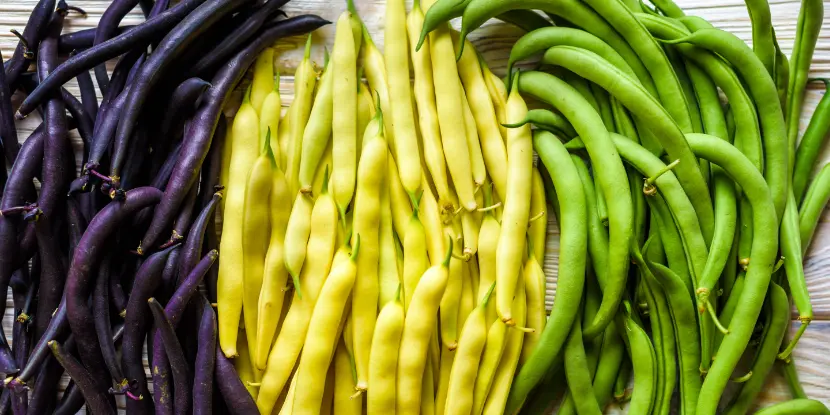
As with all vegetables, there are many varieties of string beans. Not all of them are green!
Ideal Temperature
Green beans prefer temperatures between 70°F and 85°F but can tolerate temperatures as low as 60°F and as high as 95°F.
Temperature plays a crucial role in the plant’s germination and growth. Too cold, and your seeds may not sprout. Too hot, and your plants could flag under heat stress.
Row covers or mulch can help regulate soil temperature in areas with extreme temperature fluctuations.
Seeds or Seedlings: Which Is Best?
Seedlings are the easier option if you’re new to gardening. They demand less initial care and can give you a head start on the growing season. However, seeds are cheaper and offer a wider variety of choices.
Preparing Your Garden for Green Beans
- Pick a sunny spot: Green beans thrive in full sun. Give them at least six hours of direct sunlight daily.
- Prepare the soil: Green beans prefer well-drained, rich soil with a pH between 6.0 and 7.0. If your soil is too acidic, add lime; if it’s too alkaline, add sulfur. Mix in compost or well-rotted manure to improve soil fertility.
- Row spacing: For bush beans, space rows 18–24 inches apart. Leave at least 3 feet between rows for pole beans.
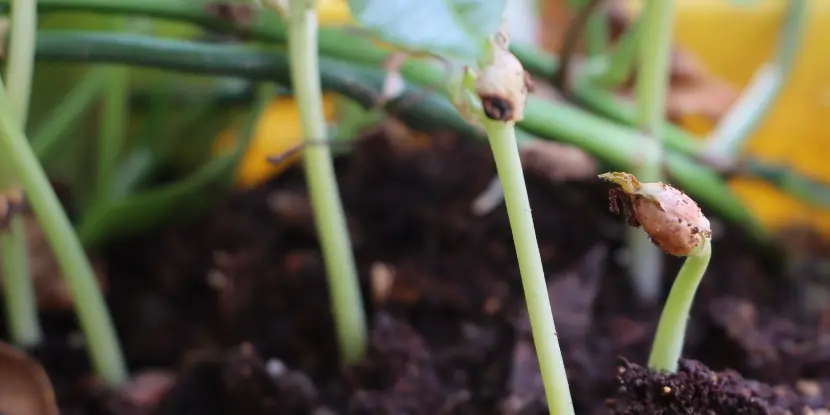
Bean plants sprouting in the garden.
Planting Green Beans
The best time to plant green beans is after the last frost date when the soil temperature has warmed to at least 60°F.
- Planting seeds: Sow seeds directly into the ground once the danger of frost has passed. Plant them about 1 inch deep and 2 inches apart. Keep the soil moist until seedlings emerge.
- Planting seedlings: Dig a hole twice as wide and deep as the container the seedlings came in. Gently remove the seedling from its container and place it in the hole. Fill the hole with soil and pat down gently.
- Support: For pole beans, install poles or trellises before planting to avoid damaging the roots later.
Care & Maintenance
- Watering: Keep the soil evenly moist but not soggy. Water at the base of the plant to avoid wetting the leaves, which can lead to disease.
- Mulch: Mulching around your plants can help retain soil moisture and keep weeds at bay.
- Fertilizing: Green beans are light feeders, so only fertilize if your soil lacks nutrients or plants show signs of nutrient deficiencies (yellowing leaves, stunted growth).
- Pest control: Watch for pests like aphids, beetles, and cutworms. Use organic methods like handpicking or introducing beneficial insects to control infestations.
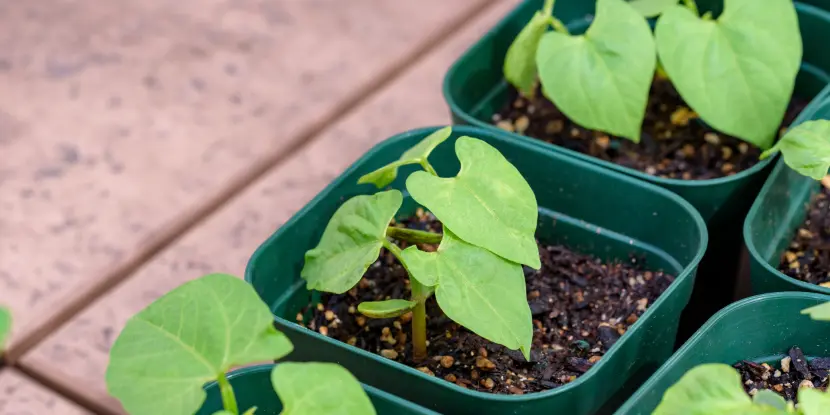
Green bean seedlings ready to be transplanted.
Symptoms of Pests of Disease
- Yellowing leaves could indicate a lack of nitrogen, easily remedied by fertilizing.
- Holes in leaves and pods: Pests like caterpillars, beetles, and slugs may be the culprit. Handpick them or introduce natural predators to control their populations.
- Wilting could be caused by over- or underwatering, so check your soil moisture levels.
Growing Green Beans in Pots
- Choose dwarf varieties for the best results
- Use a container at least 12 inches deep and wide to give your green beans room to grow.
- Install a trellis or use a tall pot with stakes to support pole beans.
- Use well-draining, nutrient-rich soil. Avoid compacted or heavy soils that can hinder root growth.
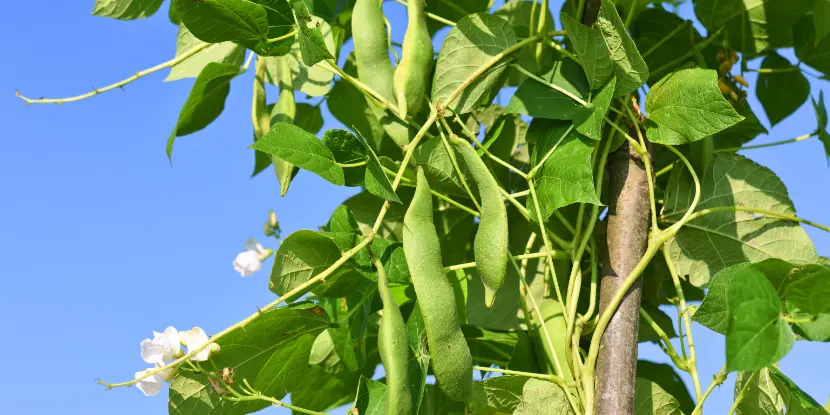
Bean pods on the vine ready for harvest.
Harvesting Green Beans
Green beans are ready for harvest when they reach their full size, but are still tender. Harvest when beans are firm and crisp, typically 50–60 days after planting
- Use clean scissors or garden shears; avoid pulling beans off the plant
- Harvest every few days to encourage more production
- Store in the fridge or blanch and freeze for later use
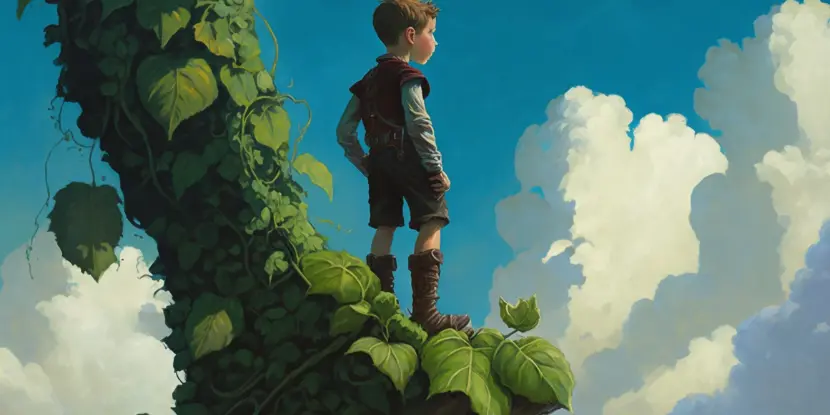
Jack, the most successful bean farmer ever.
FAQs: Growing Green Beans
Q: Are green beans and string beans the same thing?
Green beans and string beans are different names for the same vegetable. “String bean” refers to an older variety with a tough, fibrous string running along the pod’s seam.
Q: How often should I water my green bean plants?
Green beans prefer moist but not waterlogged soil. Aim to keep the top inch of soil evenly moist; depending on your climate, this may require watering every 2–3 days.
Q: Can I grow green beans indoors?
It’s possible, but beans require a lot of sunlight and space. It may be more practical to plant dwarf varieties and grow them in containers near a sunny window or on a balcony. Also, due to their climbing nature, green beans need proper support.
Do green beans need a trellis?
Pole beans must have a trellis or other support to climb. Bush beans can grow without support. Choose the variety that best suits your gardening space and preferences.
Q: How long do green beans continue to produce?
Green beans will continue to produce as long as conditions are favorable. Bush beans typically offer a single, burst harvest that lasts a few weeks, while pole beans can produce continuously for two months or more with regular picking.
Q: What can I do about powdery mildew on my green bean plants?
Powdery mildew is a fungal disease that appears as white spots on leaves. Apply a fungicidal spray or a homemade solution combining 1 teaspoon of baking soda with 1 quart of water. Ensure good air circulation around plants and avoid overhead watering to minimize the risk of mildew.
Q: How do I avoid cross-pollination if I’m growing multiple varieties of beans?
Plant different bean varieties 10 feet apart or more, or time their planting and flowering so they don’t overlap. Growing them in separate enclosed spaces like greenhouses or netting can further prevent cross-pollination.

